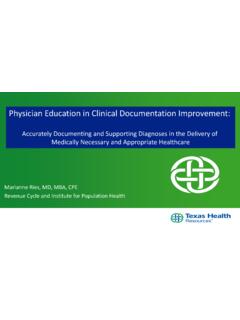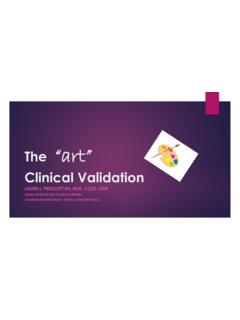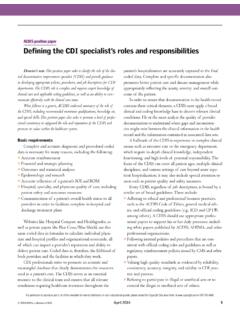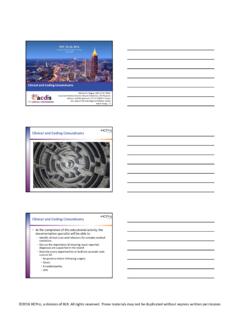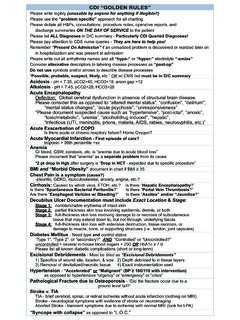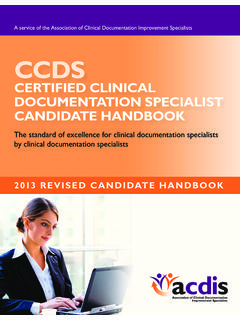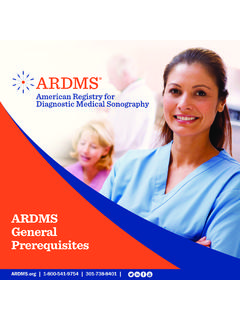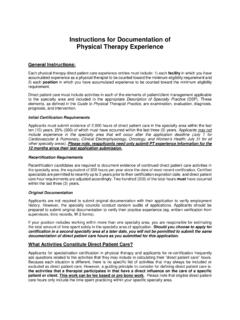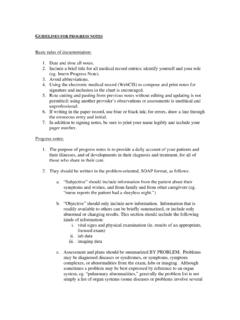Transcription of Documentation Tip Card: General Documentation …
1 1 D o c u m e n t a t i o n T i p C a r d : G e n e r a l D o c u m e n t a t i o n T i p s D e p a r t m e n t o f V e t e r a n s A f f a i r s , A l e d a E . L u t z V A M C C l i n i c a l D o c u m e n t a t i o n I m p r o v e m e n t P r o g r a m Robert S Hodges, MSN, RN: ATTN: PAS/136; 1500 Weiss Street; Saginaw MI, 48602 Phone: 989-497-2500 x13101 E-mail: clinical Documentation is important for a variety of reasons. These include: Coding accuracy and precision, Documentation of the severity of illness, Justification for resources used in providing care, Improved continuity of care for the Veteran, and Reimbursement both from the VA and commercial payers.
2 Lack of accurate and complete Documentation may not allow a Veteran to get benefits they deserve and also reflects on you as providers in other VA Medical Centers and Clinics read your notes when the Veteran either moves or seeks care at another facility. If your Documentation allows the next provider seeing the Veteran to have a better starting point, especially for recurrence of com-mon symptoms, that only helps the Veterans in getting timely care to help resolve those conditions and provides better utilization of resources to identify the underlying cause. Documentation that is not clear may result in a clarification request to allow for precise coding of the record and docu-mentation of the care provided.
3 If you have any questions or concerns regarding Documentation in the medical record, do not hesi-tate to contact the facility clinical Documentation Improvement Specialist at the phone or email below. After all, we are here to serves those who have served. Excellent Documentation supports excellent care. 2 D o c u m e n t a t i o n T i p C a r d : G e n e r a l D o c u m e n t a t i o n T i p s D e p a r t m e n t o f V e t e r a n s A f f a i r s , A l e d a E . L u t z V A M C C l i n i c a l D o c u m e n t a t i o n I m p r o v e m e n t P r o g r a m Robert S Hodges, MSN, RN: ATTN: PAS/136; 1500 Weiss Street; Saginaw MI, 48602 Phone: 989-497-2500 x13101 E-mail: Make sure you document all conditions that are impacting the patients health at the time of their visit and review any chronic conditions.
4 For example; Acute aspiration pneumonia with chronic diastolic heart failure. Acute kidney injury secondary to Sepsis or Dehydration. Morbid Obesity (BMI >39) or Malnutrition (BMI < 19) If a patient presents with symptoms, such as dyspnea, chest pain, or edema, indicate the cause or what you are ruling out. For example; Dyspnea due to COPD vs. Asthma vs. Pneumonia, Chest pain due to GERD vs. Angina vs. Costochondritis, or Edema due to Diastolic CHF vs. Chronic Kidney Disease vs. something else. When documenting conditions be as precise as possible. This allows for more accurate cod-ing and better Documentation of the patients condition.
5 For example: Systolic and/or Diastolic CHF and is it acute or chronic. Diabetes Type 1 or Type 2 and controlled or uncontrolled. Excellent Documentation supports excellent care. 3 D o c u m e n t a t i o n T i p C a r d : G e n e r a l D o c u m e n t a t i o n T i p s D e p a r t m e n t o f V e t e r a n s A f f a i r s , A l e d a E . L u t z V A M C C l i n i c a l D o c u m e n t a t i o n I m p r o v e m e n t P r o g r a m When providing patient education not only document the information provided, but also the patients response to the education you provided.
6 This is a Joint Commission standard. Make the link between conditions. If a patient has Diabetes Mellitus, do they have neuropa-thies, renal manifestations, or other issues related to that primary condition. If they have an encephalopathy, what is the underlying condition causing the encephalopathy? Links cannot be assumed or presumed and must be documented by the provider and better documents the clinical condition of the patient. Be very cautious with the use of abbreviations. The facility approved list is available under the tools menu in CPRS, but it is over 800 pages long and many abbreviations on that list have more than one meaning and mean different things in upper and lower case.
7 Improper use of abbreviations can cause confusion and may require clarification. As a General rule: Never use a slash (/) between diagnoses. Abbreviations should never be used in the final diagnosis listing If you aren t sure, write it out. Robert S Hodges, MSN, RN: ATTN: PAS/136; 1500 Weiss Street; Saginaw MI, 48602 Phone: 989-497-2500 x13101 E-mail: Excellent Documentation supports excellent care. 4 D o c u m e n t a t i o n T i p C a r d : G e n e r a l D o c u m e n t a t i o n T i p s D e p a r t m e n t o f V e t e r a n s A f f a i r s , A l e d a E.
8 L u t z V A M C C l i n i c a l D o c u m e n t a t i o n I m p r o v e m e n t P r o g r a m Acute vs. Chronic. It s important to document conditions as Acute or Chronic, or even an Acute Exacerbation of a Chronic condition, such as CHF, COPD or Chronic Kidney Disease. This helps capture the severity of illness as well as precision in coding. Insufficiency vs. Failure. These two terms are often used synonymously in medical prac-tice, but they do not mean the same thing and indicate different levels of severity. Insufficiency more accurately describes an new change or an acute change in a chronic condition that can be treated as an outpatient or observation status and is expected to return to baseline with minimal intervention that cannot be staged or classified using established criteria.
9 Failure usually indicates something more serious or dramatic in nature which , if acute in nature, may require inpatient or critical care services and may have im-pact on other body systems. If chronic in nature, the condition will require con-tinued care an monitoring and is not expected to improve in the long term. These conditions should be able to be staged or classified using existing standards. Robert S Hodges, MSN, RN: ATTN: PAS/136; 1500 Weiss Street; Saginaw MI, 48602 Phone: 989-497-2500 x13101 E-mail: Excellent Documentation supports excellent care.
10 5 Minimum requirements for a level 1 exam are: S - Chief Complaint: history of present; 1 of the 8 elements must be documented: location, dura-tion, timing, severity, quality, context, modify factors, associated symptoms (New patient). O - Minimum of 1 body system/area ( GI: GU: CV: Skin: Musculoskeletal, etc) A - One minor problem identified ( cold, insect bites, influenza, etc.*) or being seen for previ-ously diagnosed problem that is stable or improving. P - Minimal treatment required ( injection, bed rest, and chest x-ray/lab tests) *Many Veterans have multiple chronic conditions which may increase the level of care.
